Our History
On the 19th October 2018 Adam,Rouilly proudly marked the Centenary of the founding of the Company. For 100 years Adam,Rouilly has been serving medical education. From its earliest beginnings in London in 1918 to a present-day worldwide network of distributors, the focus on quality and service has remained unchanged.
On the 19th October 2018 Adam,Rouilly proudly marked the Centenary of the founding of the Company. For 100 years Adam,Rouilly has been serving medical education. From its earliest beginnings in London in 1918 to a present-day worldwide network of distributors, the focus on quality and service has remained unchanged. See more about our history below. A special commemorative booklet for the Adam,Rouilly Centenary can be requested here.
2018
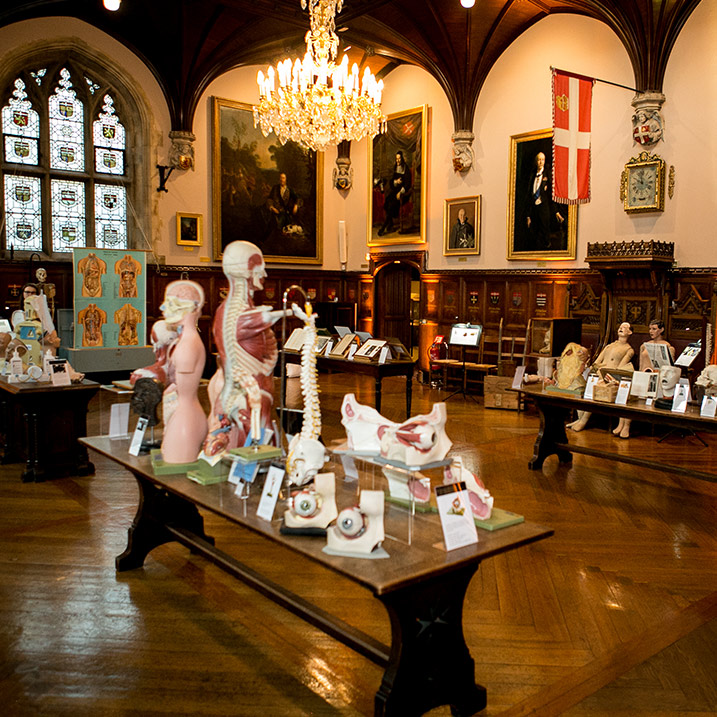
Adam,Rouilly Centenary
On the 19th October 2018 Adam,Rouilly proudly marked the Centenary of the founding of the Company. Guests, including customers, suppliers and distributors from around the world, gathered at the Museum of the Order of St John in London to celebrate the founding of the Company by Guy Rouilly in 1918.
The venue itself was chosen as Saint John Ambulance was a very early customer of Adam,Rouilly. More about this special event here.
2001 – Present
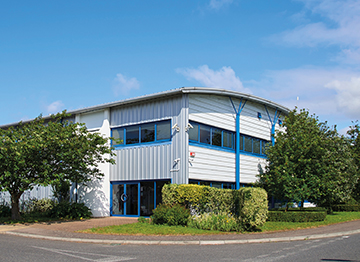
Castle Road
In 2001 Adam,Rouilly moved from Crown Quay Lane into a purpose built factory on Castle Road. From this single location in Sittingbourne all design, manufacturing, distribution, sales and marketing activities are undertaken.
A dedicated team looks after UK and international sales and customer service, maintaining the high standards established by Guy Rouilly a century ago.
The future for Adam,Rouilly is to uphold Guy Rouilly’s founding principles of offering excellent products and service.
Our motivation is simple, to help train future generations of healthcare professionals and continue to serve medical education worldwide.
2012

Anatomical Excellence
Guy Rouilly recognised the superb quality of SOMSO® models in 1927 and today these are the only Anatomical Models that Adam,Rouilly supplies to Hospitals, Universities and Medical Schools worldwide. Today the SOMSO® company continues to be run by the Sommer family.
In 1964 SOMSO® produced the first plastic torso MT14, and through many developments this model remains highly popular. The material used today, SOMSO-Plast®, is a virtually unbreakable plastic.
In May 2012 Adam,Rouilly was asked to supply SOMSO® models to complement the anatomical drawings being displayed for the exhibition ‘Leonardo da Vinci Anatomist’ at The Queen’s Gallery Buckingham Palace.
1990
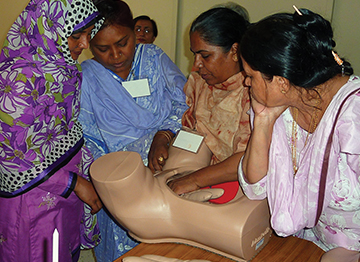
Customers from Abroad
The name Adam,Rouilly became known worldwide from the early 1920s. Carefully selected dealers were entrusted with the Adam,Rouilly name in their territories. Dealerships often last for many decades and relationships are based on following the same ethical business values adhered to by Guy Rouilly.
During the 1990’s additional suppliers from USA, Japan and Europe were carefully selected to uphold the Adam,Rouilly reputation for offering products of reliability and quality.
Promoting Adam,Rouilly products involves visiting established customers in all five Continents as well as exploring markets in countries such as Pakistan, China, Indonesia, Russia, Mexico and Saudi Arabia. Regular training events for Adam,Rouilly products maintains close contact.
1984
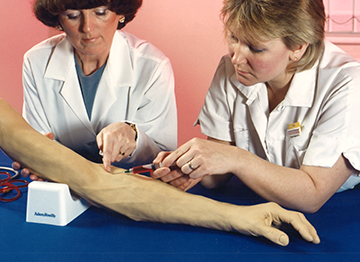
Product Development
Developing new products has always been in response to a need. The Infusion Arm Trainer was initially produced for military training where the problem was finding an arm that was both realistic but also robust enough to withstand the multiple uses required for giving soldiers basic first aid and intravenous cannulation training.
The original Injection and Infusion Arm Trainer, launched in 1984, had a bag-based system. With the advancement of materials, a softer silicone skin replaced the less durable PVC in 2009. An easy- to-use sealed bottle system replaced blood bags.
1976
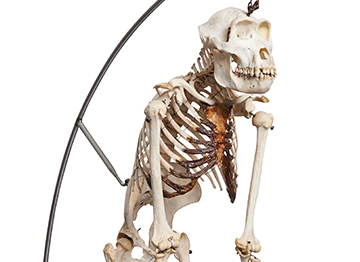
Comparative Anatomy
Adam,Rouilly is less well known for offering Botanical, Zoological, Anthropological and Veterinary Models.
Gorilla skeletons featured prominently in the early records and the Grant Museum of Zoology, University of London purchased a complete disarticulated skeleton in 1928 . The last articulated skeleton sold was to the University of Birmingham, Department of Comparative Anatomy. As transporting a gorilla was awkward, it had to be delivered in person and was driven from London to Birmingham in the front seat of a Triumph Herald Coupé.
1976
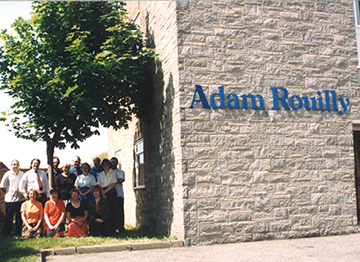
Crown Quay Lane
Adam,Rouilly remained in Tottenham Court Road until 1972. With the expansion of the company, the showroom and warehousing facilities were insufficient and a showroom opened in Swiss Cottage, London with a manufacturing and production facility and distribution centre located at a new industrial complex in Sittingbourne, Kent. Sittingbourne was originally chosen because it was well positioned in the South East of England, located an hour away from London and within easy access links to the rest of the UK, Europe and beyond.
The London office closed in 1976 and Unit 40 on Crown Quay Lane became the company headquarters for the next 25 years.
1970
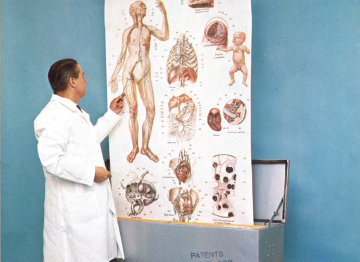
Charts
It is difficult to appreciate how important wall charts used to be in the classroom when today, in the digital age, they are viewed as decorative items. Over a third of Adam,Rouilly’s 1930 catalogue was given over to charts and many hundreds of thousands were sold.
In the early 1970s, The Chart Cart was developed. This metal box held up to 20 titles mounted on wooden spring rollers. When raised the chart was secured in place by a support. The cart was compact, and the castors enabled it to be positioned as required. The idea was so well designed that it was patented.
1967
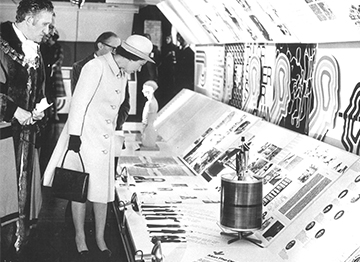
Exhibitions
Initially exhibitions related solely to specialities, such as Nursing, Midwifery, Physiotherapy, Obstetrics and Gynaecology but over the years more generic Clinical Skills Conferences feature on the calendar.
Exhibitions are often the first point of contact with customers and over the decades many famous faces have visited one of the Adam,Rouilly stands.
Today, Adam,Rouilly regularly meets healthcare professionals at exhibitions in the United Kingdom and also exhibits overseas at Medica – Germany, Arab Health – UAE and IMSH – USA. Anatomical Institutes hold regular meetings in the UK which Adam,Rouilly has attended for many years engaging with those involved in anatomy teaching.
1965
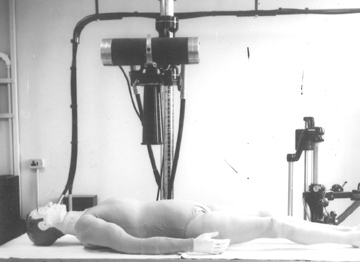
The X-Ray Doll
Approached by the Royal Herbert Military Hospital, Woolwich, London in the early 1960s, Adam,Rouilly produced a doll for radiographic positioning training.
Life sized and accurately proportioned, the doll contained a specially selected human skeleton and papier- mâché head with an embedded skull. The doll was totally radiolucent and the representations of the internal organs were positioned to correspond accurately with the surface anatomy.
Following the ban on the importation of natural bones in the UK, in the mid-1980s, a special grade of polyurethane was developed which produced the same level of radiolucency which is used in today’s X-Ray Doll.
1964 – 1976
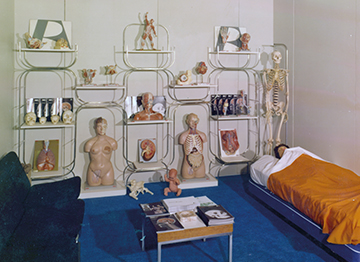
Tottenham Court Road
In 1964 Adam,Rouilly moved to Shropshire House, 179 Tottenham Court Road with the showroom continuing to open on Saturday mornings at the beginning of term for the sale of half skeletons and skulls to medical and dental students.
Doctors from all over the world studied in London and the name Adam,Rouilly became known worldwide.
Management changes took place in the mid 1960’s and Guy Rouilly also retired from the company.
1931
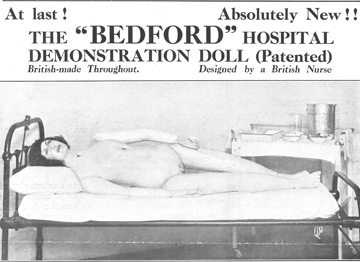
The Bedford Doll
In 1931, Adam,Rouilly introduced the Bedford Hospital Demonstration Doll. Developed in co-operation with Miss Bedford, a clinical tutor at one of the London Nursing Schools.
The Bedford Doll was life-size, with removable and jointed legs and arms, a papier-mâché head with realistic glass eyes. The standard doll came supplied with painted imitation hair, whilst a natural hair wig was optional.
These fabric covered nurse training dolls were unique with their soft, palpable skin making them look and feel lifelike. Although the early dolls bear little resemblance to the models in production today they continue to be used worldwide to teach basic nursing skills.
1927
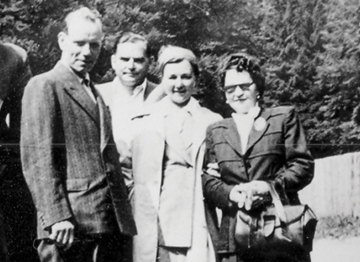
Early Connections
In 1927, Guy Rouilly met Marcus Sommer who was on a sales tour in London. Impressed by the anatomical models being offered he placed his first order. The close co-operation between the two formed the basis of an enduring personal relationship which still continues to this day between Adam,Rouilly and SOMSO® Modelle.
The SOMSO® Sun is the registered trademark and the name originates from SOMmer, the family name and SOnneburg, the town where the Company was founded in 1876.
1926

Natural Bone Half Set
Natural bone half sets were required by medical students so that they could closely examine the markings and surface anatomy of individual bones.
Half sets were supplied in wooden boxes hand made by Frederick Sale. Each would be stencilled with the Adam,Rouilly logo and a marketing label would be fixed to the lid.
A half set comprised of; an articulated skull with horizontal section, complete vertebral column, innominate, sacrum and coccyx, half sternum, a hand and foot, ribs, scapula, clavicle, humerus, radius, ulna, femur, patella, tibia and fibula of one side.
1925
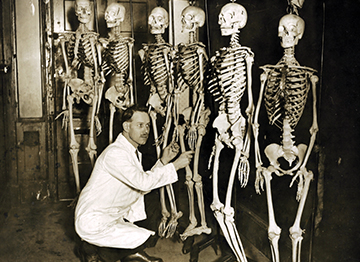
Inspecting Skeletons
Guy Rouilly would personally inspect every skeleton before it was delivered to a customer.
In the early days bones and skeletons were purchased from France, Russia, Germany and India. Reknas, Calcutta, India became the principal supplier from 1937. Guy Rouilly built a relationship with the owner, Sanker Sen, which lasted for almost fifty years. The trade came under scrutiny in the late 1970’s and the exportation of natural bone material ceased in 1985.
Complete disarticulated skeletons would be delivered and, generally, each set of bones came from a single individual. The bones would then be assembled to make up a complete skeleton.
1924
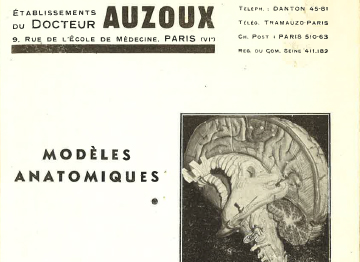
Early Models
In the early days, Établissements du Dr Auzoux in France supplied a limited range of extremely detailed papier-mâché models. More robust than wax these models were described as ‘clastic’ as they could be disassembled.
Auzoux models were transported from France in wooden crates and although arriving intact, the numbering, cut from newsprint and glued on, would often become unstuck requiring remedial work before being despatched to Adam,Rouilly customers.
Guy Rouilly catalogued many Auzoux models including a series of natural bone joint models of hands, feet, elbows and shoulders on which the ligaments were represented using hemp, which was very strong.
1924

Early Models
Professor Werner Spalteholz, Leipzig, developed a process for making organs transparent or translucent then stained in various colours. These preparations were catalogued by Guy Rouilly from the 1920s.
University College London Medical School, purchased at least 20 Spalteholz specimens, possibly with money gifted by the American Rockefeller Foundation for advancement of the Anatomy Department.
A sale to the University of Otago meant that the preparations had to make a trip of 14,000 miles to reach New Zealand. 94 years later the University Anatomy Museum still has the original preparations supplied by Adam, Rouilly.
1924
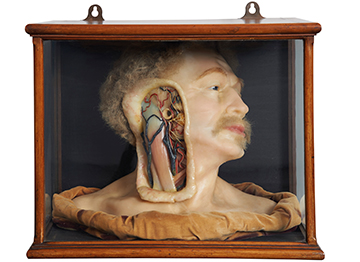
Early Models
As a businessman, Guy Rouilly endeavoured to offer a wide choice of teaching material, including wax, papier mâché and plaster models and natural preparations from a variety of sources in the early days of Adam,Rouilly.
Company records show sales of wax models up to the late 1920s as plaster and papier mâché replaced wax as more robust materials were required for teaching.
The wax head, probably French, is an example of ecorché modelling where the skin has been removed to show the underlying musculature. The plaster model, produced by Franz Josef Steger and Carl Ernst Bock at the University of Leipzig, was from a collection purchased through international catalogues.
1924

Sales Day Book
The early Sales Day Books were usually written up by Guy Rouilly in his very distinct, but somewhat illegible handwriting. Different handwriting would denote his absence. Guy, and his wife Marie adopted the French custom of taking holidays in August and they would visit family in Paris, Puy de Dome and the Loire.
Early Company records indicate that through connections with surgical instrument makers, Guy Rouilly built up a network of trading partners. The first recorded sales transactions were for clearance charges for items being imported from Germany, 12 half skeletons in boxes priced at four guineas and a disarticulated skull in a box.
1922 – 1964
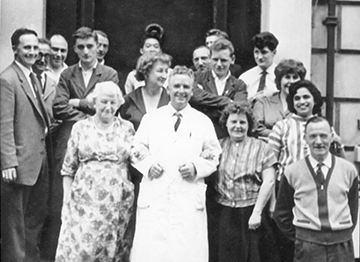
Early Staff – Fitzroy Street
The layout of Fitzroy Street explains the day to day workings at No. 18 and the group photograph, taken in early Summer 1962, shows the then employees.
On entering the showroom on the ground floor, via an impressive front door with its distinctive knocker, customers were presented with an extensive display of skeletons, models and charts. These would be demonstrated by Albert Petts who worked alongside every member of staff since his early beginnings in 1922
The sack trolley, which is still in use today, was wheeled to the Post Office with the daily parcels by the packer
1922

In the Beginning
Albert Petts joined Adam,Rouilly at the age of 14 and he worked for the company from 1922 until his retirement in 1973.
One of his first jobs was a delivery to East Dulwich Hospital. Albert set off on the six-mile journey pushing a handcart loaded with heavy plaster models. The road to Camberwell was fairly level but then the cart had to be pushed up Denmark Hill past Kings College Hospital, over the top of Camberwell Grove and down Dog Kennel Hill where the cart almost ran away with him. He arrived so exhausted that the Matron insisted on sending him back by ambulance with the hand cart towed behind. The greengrocer, who had loaned the cart, took pity on him and let him keep threepence of the sixpence charge.
1920
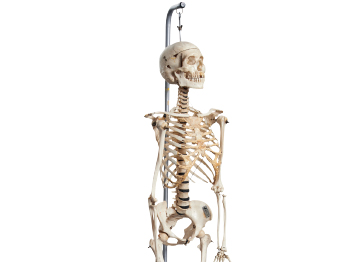
The House of Osteology
From the 1920’s Guy Rouilly supplied articulated skeletons to all the London Medical Schools and Teaching Hospitals.
With his background in metal work Guy Rouilly was knowledgeable in the materials required to achieve realism and durability for his preparations and he strived to ensure that the material he offered was of the highest quality. Staff were trained in the selection, articulation and mounting of natural bones and these skilled workers were known as osteologists.
First Class’, ‘Second Class’, ‘Third Class’ and ‘Fourth Class’ were terms used to grade skulls. They related solely to the skull condition and were in no way connected to any social class.
1900 – 1918

The Comma
The Adam,Rouilly name prompts questions: Why the Adam? Why the ‘,’ between Adam and Rouilly? The story that Guy Rouilly took over the business from his father, with a Mr Adam, a man who mysteriously vanished and cannot be verified.
A possible explanation is that the name E. Rouilly and Sons appeared far down in trade listings. By listing the company a second time as Adam,Rouilly, with two surnames, it now came at the top under ‘A’. Fitzroy Square was designed by the Adam family of architects in the 17th Century, and there was an Adam designed fireplace in 18 Fitzroy Street both of which could have been directional pointers.
1913 – 1919
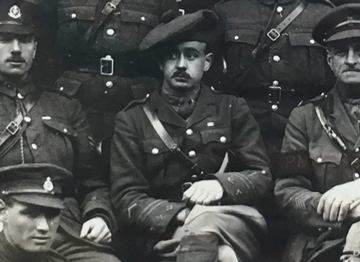
Military Service
Guy Rouilly, the third of five children born to Emile and Julie Rouilly was both a British Subject and a French citizen. In 1913, aged 20, he was conscripted into the French Army. On the declaration of war, posted to an infantry regiment on the Western Front, he fought in the Battle of Verdun. Wounded in 1917, he later returned to the trenches to fight in Flanders and the Lorraine front. Decorated for “bravery beyond all praise” he received the Croix de Guerre with bronze star and The Military Medal.
Guy Rouilly re-joined the family business after the war but was only able to work alongside his father for six months as Emile Rouilly died in February 1920 aged 53.
1900 – 1920

Artistic Connections
During the time Adam,Rouilly occupied 18 Fitzroy Street many hands, with artistic connections, touched the door knocker.
Painter Augustus John and his wife Ida lived in the top floor flat from 1901 and their son Casper was born there in 1903. John’s studio at No 18 was also the headquarters for The Chelsea Art School. A stream of artists, models, family and friends knocked on the front door and climbed the stairs.
In 1920, artists Bernard Menisnky and Roger Fry were living in No 18 and history repeated itself as members of the Bloomsbury Group of artists, writers and intellectuals also now visited.
Image right, © National Portrait Gallery, London
1900 – 1964

18 Fitzroy Street
18 Fitzroy Street, the white building on the left of the picture, was leased by the Rouilly family from 1900. The rent paid was £110 per annum.
Built in 1790, the terraced house comprised a basement with flat, four storeys above and a single storey workshop at the rear. It was used as offices, showrooms and workrooms with the two top floors let as flats.
No 18. was the Adam,Rouilly headquarters until 1964.
Image left, © London Metropolitan Archives
1900 – 1964

Emile Rouilly & Sons
Monsieur Guy Rouilly, the principal founder of Adam,Rouilly, originally worked for his father’s company, E. Rouilly and Sons. Emile Rouilly came to England in the late 1880’s, from France, and by 1900 was representing Maison Fontaine as a distributor for the diverse array of architectural fittings manufactured by this renowned Paris company.
From 1900 the Rouilly family were listed in street directories first as bronze chasers, then art metal workers and finally surgical instrument makers trading as both Emile Rouilly & Sons and Adam,Rouilly & Co.
From 19 October 1918 the bronze chasing ceased, the surgical instrument side reduced and business was advertised solely as “Anatomists, Osteologists and Human Skeletons.”